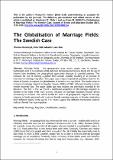The globalisation of marriage fields : the Swedish case
Date
08/2010Metadata
Show full item recordAbstract
Marriage fields - the geographical areas where people meet to partner traditionally tend to be relatively small and local. Increasing international travel and the use of the internet have broadened the geographical opportunity structure of potential partners. This increases the chances of meeting a partner from abroad, possibly resulting in a rise in international marriage migration. This paper uses unique longitudinal population data for the whole of Sweden to explore the globalisation of Swedish marriage fields. The results show an increase of 'marriage migrants' in Sweden between 1990 and 2004, although absolute numbers remain relatively low. The paper yields two new insights not previously recorded in the literature. First, we found a substantial proportion of all marriage migrants in Sweden to be males, while most existing literature on marriage migration focuses almost exclusively on females. Second, the pattern of geographical origins of marriage migrants is highly gendered, with male and female marriage migrants in Sweden originating from different regions in the world. This suggests that different mechanisms underlie male and female marriage migration.
Citation
Niedomysl , T , Osth , J & Van Ham , M 2010 , ' The globalisation of marriage fields : the Swedish case ' , Journal of Ethnic and Migration Studies , vol. 36 , no. 7 , pp. 1119-1138 . https://doi.org/10.1080/13691830903488184
Publication
Journal of Ethnic and Migration Studies
Status
Peer reviewed
ISSN
1369-183XType
Journal article
Collections
Items in the St Andrews Research Repository are protected by copyright, with all rights reserved, unless otherwise indicated.

